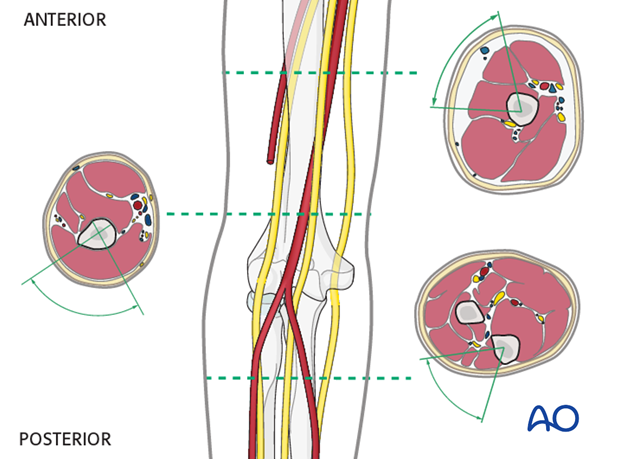Temporary external fixation
1. Introduction
The modular external fixator is optimal for temporary use. It is rapidly applied without need for intraoperative x-rays and can be adjusted later.
The biggest risk of temporary spanning external fixation of the proximal forearm is iatrogenic neurovascular nerve injury.
Knowing the safe zones and blunt dissection to bone is critical.
2. Positioning
The patient is placed in a supine position:
3. Pin site preparation
Pin placement
For safe pin placement make use of the safe zones and be familiar with the anatomy of the humerus and the forearm.

Soft tissue dissection
Blunt dissection of the soft tissues and the use of small Langenbeck retractors will prevent damage to muscular, vascular and neurological structures.
Prepare a channel for insertion of the pin, using a blunt clamp down to the bone. If there is any doubt an incision should be made big enough to prove that the drill sleeve (mandatory for the humerus) will have direct contact with the bone.

4. Implementation of modular external fixation
Details of external fixation are described in the basic technique for application of modular external fixator.

5. Aftercare following external fixation
Positioning
The arm is supported in a “collar-and-cuff” sling for comfort.
Proper pin insertion
To prevent postoperative complications, pin-insertion technique is more important than any pin-care protocol:
- Correct placement of pins (see safe zones) avoiding ligaments and tendons, eg tibia anterior
- Correct insertion of pins (eg trajectory, depth) avoiding heat necrosis
- Extending skin incisions to release soft-tissue tension around the pin insertion (see inspection and treatment of skin incisions)
Pin-site care
Various aftercare protocols to prevent pin tract infection have been established by experts worldwide. Therefore, no standard protocol for pin-site care can be stated here. Nevertheless, the following points are recommended:
- The aftercare should follow the same protocol until removal of the external fixator.
- The pin-insertion sites should be kept clean. Any crusts or exudates should be removed. The pins may be cleaned with saline and/or disinfectant solution/alcohol. The frequency of cleaning depends on the circumstances and varies from daily to weekly but should be done in moderation.
- No ointments or antibiotic solutions are recommended for routine pin-site care.
- Dressings are not usually necessary once wound drainage has ceased.
- Pin-insertion sites need not be protected for showering or bathing with clean water.
- The patient or the carer should learn and apply the cleaning routine.
Pin loosening or pin tract infection
In case of pin loosening or pin tract infection, the following steps need to be taken:
- Remove all involved pins and place new pins in a healthy location.
- Debride the pin sites in the operating theater, using curettage and irrigation.
- Take specimens for a microbiological study to guide appropriate antibiotic treatment if necessary.
- Before changing to a definitive internal fixation an infected pin tract needs to heal. Otherwise infection will result.
Rehabilitation
In the rare event that external fixation has been used as the definitive management of a proximal forearm fracture, there is a significant risk of marked stiffness of the elbow joint. A prolonged program of rehabilitation under the supervision of the surgeon and an experienced physical therapist will be necessary.
Follow up
See patient 7-10 days after surgery for a wound check. X-rays are taken to check the reduction.













